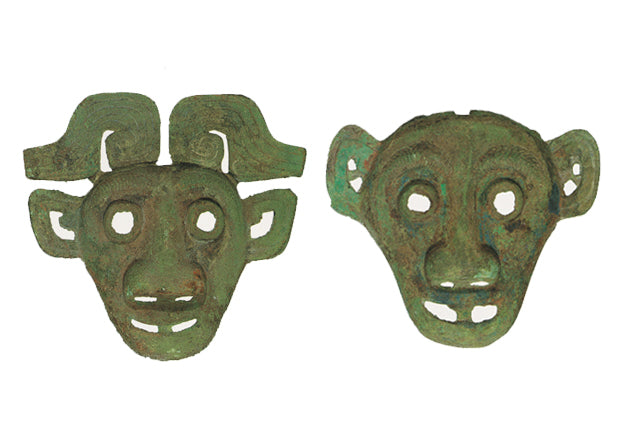
Bronze face ornaments

Bronze facial ornament, bronze ware, Western Zhou cultural relic, left height 15.7 cm, width 16.3 cm, right height 15 cm, width 17.1 cm, thickness 0.3 cm, unearthed from Tomb 84 of the Ying State Cemetery in Pingdingshan, Henan Province in 1986.
In the 1980s, archaeologists excavated a Zhou Dynasty Ying State cemetery in Beiqi Village, Xuezhuang Township, Pingdingshan, Henan Province, and unearthed a large number of precious cultural relics. Among them, Tomb 84 unearthed more than 130 pieces (sets) of burial objects, and this set of bronze facial ornaments was unearthed from this tomb. Based on the unearthed objects and inscriptions on many bronze ware and other related information, researchers inferred that the owner of Tomb 84 should be a monarch of the Ying State during the period of King Gong of the Western Zhou Dynasty [1].
A total of 8 bronze facial ornaments were unearthed in this tomb, all of which imitated human faces. They can be divided into two types based on hairstyle, 4 pieces each. All eight bronze facial ornaments have thick eyebrows; the eyes are convex and the pupils are nearly round; the nose is straight, the nose wings are wide, and there are two nostrils; the mouth is a crescent-shaped hole, and there is a longitudinal beam between the upper and lower lips, which seems to be used for threading; the ears have flat edges. One type has long cirrus-like hair on the top of the head, which is split in the middle and curled symmetrically in front of the forehead. There is a horizontal beam on the back of the hair end that connects to the top of the head and can be used for threading; the other type is roughly the same as the former, but there is no hair on the top of the head, the face is wide, the ears are close to the top, there are holes on the top of the head; there is an arc-shaped hole in the middle of the ear. When these bronze facial ornaments were unearthed, there were silk prints on the surface, which are suspected to be the marks left by the wrappings when they were buried. (Figure 1)
Figure 1 Line drawing of bronze face decoration unearthed from Ying State Cemetery in Pingdingshan
This group of bronze human face decorations in the collection of Henan Museum was unearthed from Ying State Cemetery in the Western Zhou Dynasty. Ying State was a fiefdom of the Ji clan in the early Zhou Dynasty. It was established for more than 300 years. It was not far from Haojing in terms of geographical location and may have been influenced by it in terms of culture, but it had a unique style in terms of artifacts and statues, with its own characteristics. When the artifact was unearthed, it was placed on the top board of the coffin with copper axes, shovels, bells, rings, leather belt buckles and jade handle-shaped objects. After some of them were scattered, they were mixed with copper ritual objects placed between the coffins. Jade Qi (or Yue) and primitive porcelain gui were also unearthed in the same tomb. Jade Qi was a ceremonial weapon in sacrificial places and also a symbol of power. It is speculated that this group of bronze face decorations may be a tool to mark the identity of the owner.
The bronze facial ornaments unearthed from Tomb No. 84 of the Ying State Cemetery in Pingdingshan City, Henan Province are well-preserved, well-made, and unique in shape, providing valuable information for the study of the ancient Ying State's burial system, secular rituals, etc.


![8.3"China Shang Dynasty,Bronze wine cup [Fuhao Jue cup][妇好爵杯]](http://bronzc.com/cdn/shop/files/4ee0482982cfa89bb4d1cff3333a55e6_e3ca0b86-22fc-497d-9afd-578c551225a3-2.jpg?v=1733986652&width=533)

![12.8" China Ming Dynasty, Phoenix-patterned bronze vase[Ming Wanli Phoenix-patterned vase][明万历凤纹瓶]](http://bronzc.com/cdn/shop/files/4ee0482982cfa89bb4d1cff3333a55e6_a516991b-2bb9-4b2f-a2b6-4354129d006c.jpg?v=1733986953&width=533)

![14.6" China Eastern Han Dynasty Bronze vessel in the shape of a flying horse,Also known as bronze galloping horse[Horse Stepping on Flying Swallow][马踏飞燕]](http://bronzc.com/cdn/shop/files/4ee0482982cfa89bb4d1cff3333a55e6_aa3fbeb8-e08b-4a44-929a-13411ca8fb17-2.jpg?v=1733987211&width=533)

![5.9"China Tang Dynasty, Bronze of a walking dragon[Tang Walking Dragon][唐走龙]](http://bronzc.com/cdn/shop/files/2_8cb416b9-ebbd-4fe2-a905-b9277f820c16.png?v=1731488701&width=533)
